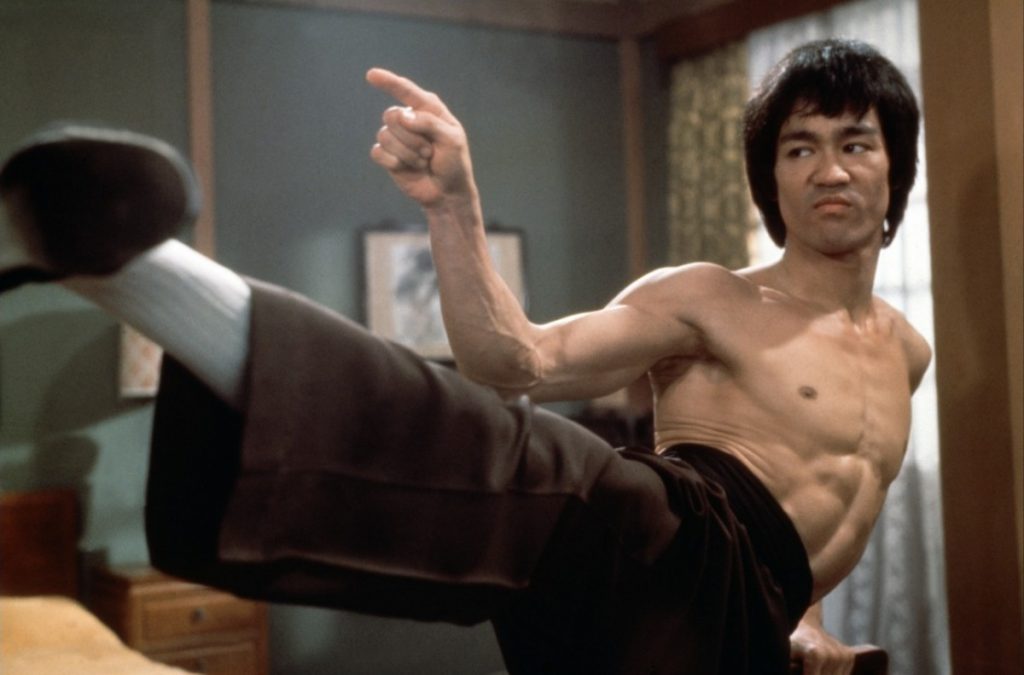Bruce Lee needs little introduction to those who are interested in martial arts. Chances are, readers of this blog have seen at least parts of one or more of his movies. In our classes on pugilism, we sometimes talk about the mechanics of his notorious “1-inch punch” as a way of reminding students to use their lower bodies to generate powerful punches. Although his initial martial arts training was primarily in Wing Chung, Bruce Lee is notable for his tireless dedication to exploring a wide variety of movement systems including Eastern and Western martial arts, dance, and any number of approaches to physical and mental training.
Jeet Kune Do
Lee’s approach to martial arts is probably best exemplified -- at least in written form -- in his book Tao of Jeet Kune Do. In the introduction to the copy of the book I have, Lee’s wife Linda states that much of Tao of Jeet Kune Do was completed after he sustained a serious back injury: “This was probably the most trying and dispiriting time in Bruce’s life. He stayed in bed, virtually flat on his back from six months, but he couldn’t keep his mind from working -- the result of which is this book . . . . He intended it as a record of one man’s way of thinking and as a guide, not a set of instructions” (p. 5). Lee’s way of thinking is worth considering for any student of martial arts.
Jeet Kune Do (JKD, the way of the intercepting fist) is taught all over the world both by Lee’s former students and those who form study groups to interpret Lee’s ideas. The last time I looked at Tao of Jeet Kune Do in detail was about a decade ago, when I was training in a martial art that was heavily influenced by certain schools of chu’an fa (more commonly referred to as kung fu). A few weeks ago I was re-organizing a bookshelf and I came across Lee’s book.
My bookshelf project was interrupted by flipping through these once familiar pages. I was amazed at how many references there were to principles we frequently discuss in the Bartitsu program at Academie Duello. To be clear, I am not at all suggesting that Bruce Lee had any knowledge of Bartitsu. He did, however, have a lot of interesting things to say about three of the component martial arts that we study in the Bartitsu system every month and about the philosophy of combat and martial arts more generally. What follows is a sampling of Lee’s ideas about grappling and jiujitsu.
Jiujitsu
Lee distinguished between throws and takedowns, the same way that we do in our Bartitsu curriculum. It is clear that he practised variations of what we call the back-heel throw, the lever throw, and our jiujitsu defence against a side kick. Lee also dealt with what we would call the rear-naked choke, the chancery, and the guillotine as well as a number of joint locks. There is an interesting, illustrated section called “studies on judo and jiu-jitsu” that clearly indicates many of our introductory techniques such as an arm bar, a come-along hold, and a trust arm lock and the more advanced concept of the sacrifice throw.
Some of Lee’s advice about grappling:
Do’s:
- Keep moving
- Be prepared for counters
- Make the opponent wrestle your way
- Be aggressive; make your opponent think defense
Don’ts:
- Don’t cross your legs
- Don’t chase your opponent
- Don’t rely on one takedown; be ready for other openings
- Don’t let your opponent circle you
There is a lot to unpack here, and I encourage readers to spend some time considering the implications of Lee’s ideas for their grappling and jiujitsu training. A lot of these “do’s” and “don’ts” come down to: don’t “plant” and assume you can react to whatever comes your way. Throughout the book, Lee writes a lot about the importance of mobility, particularly because it keeps your opponent off balance:
“Distance is continually shifting relationship, depending on the speed, agility, and control of both fighters. It is a constant, rapid shifting of ground.... One finds firmness in movement, which is real, easy, and alive” (pp. 139-142).
Sometimes when we practice grappling or jiujitsu, there is a tendency to plant our feet and “settle in”. I think the temptation exists because we are conditioned to avoid falling regardless of our martial practice. Being planted and focusing on an opponent’s arms or neck, or waiting for the moment where you can step behind and go for a back heel throw might feel safer. Lee reminds us of the problems with this approach. If you aren’t moving, your opponent is either not moving or controlling your movement. Practice moving, changing guards and grips (you don’t always have to default to collar-and-elbow, although it’s a good position to learn from) and get comfortable being light on your feet while remaining in good structure. Don’t dream of that “golden opportunity” in jiujitsu, when your opponent’s leg is out in the open just waiting to be swept away. Be ready to improvise from the toolkit you developed in class. Commit to a jiujitsu technique but do not assume it will work -- be ready to apply a technique in the other direction when your opponent resists. In our introductory Fight Like Sherlock Holmes course , you will learn that an opponent who resists a come-along hold can be dealt with by using a figure-4 takedown. Most jiujitsu techniques work in this way. Be ready for other openings.
Next time, I will examine Lee’s comments about striking with the hands and feet in light of our studies in pugilism and savate in the Bartitsu curriculum.
References
Lee, Bruce. 1994. Tao of Jeet Kune Do. Santa Clara, CA: Ohara Publications, Incorporated.
